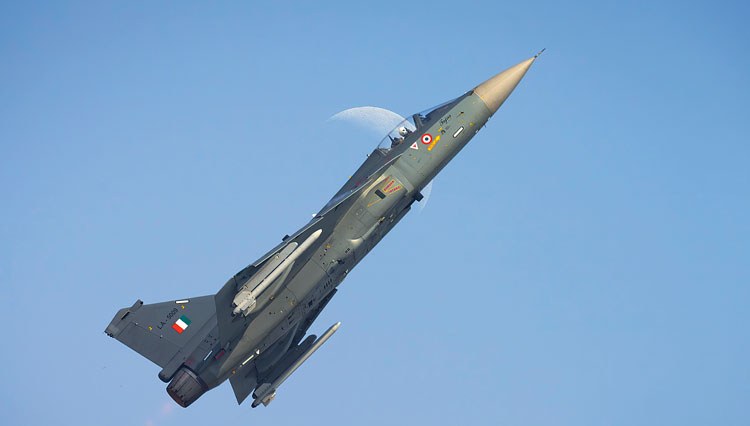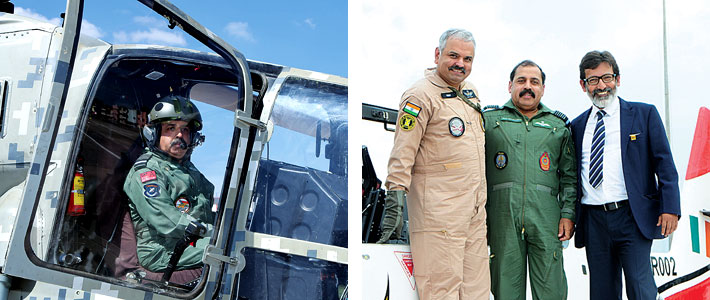INDIAN ARMED FORCES CHIEFS ON OUR RELENTLESS AND FOCUSED PUBLISHING EFFORTS

SP Guide Publications puts forth a well compiled articulation of issues, pursuits and accomplishments of the Indian Army, over the years

"Over the past 60 years, the growth of SP Guide Publications has mirrored the rising stature of Indian Navy. Its well-researched and informative magazines on Defence and Aerospace sector have served to shape an educated opinion of our military personnel, policy makers and the public alike. I wish SP's Publication team continued success, fair winds and following seas in all future endeavour!"

Since, its inception in 1964, SP Guide Publications has consistently demonstrated commitment to high-quality journalism in the aerospace and defence sectors, earning a well-deserved reputation as Asia's largest media house in this domain. I wish SP Guide Publications continued success in its pursuit of excellence.
EXCLUSIVE INTERVIEW TO SP’s
“Our challenge is to increase the synergy and cohesiveness to ensure joint operations in true sense. Air Power would play a very significant and critical role.”
In an exclusive interview to Jayant Baranwal, Editor-in-Chief, SP’s Aviation on the occasion of Aero India 2021 Air Chief Marshal R.K.S. Bhadauria, Chief of the Air Staff, gave some very candid, genuine and insightful responses

SP’s Aviation (SP’s): Rafale’s ongoing induction
(a): How do you feel about Rafale - combination of Beauty and Beast? What kind of capabilities is this bringing to our Air Force?
Chief of the Air Staff (CAS): Without any doubt, the aircraft has provided a significant boost to the IAF’s overall combat capability. The onboard avionics, weapon systems, radar and enhanced survivability features makes it one of the most potent fighter platforms in the region. The outstanding weapon carrying capability, in terms of advanced BVRs and precision long range stand-off A-G weapons has provided the IAF the decisive edge over our adversaries.
“The future battle scenarios would increasingly become more complex and advanced unmanned air systems and optionally manned next generation combat vehicles would increasingly feature in inventories of the air forces”
(b): While we are set to get 36 Rafale inducted by 2022, do you think just two squadrons- even if Rafale indeed remains one of the best fighters in the world and can therefore be interpreted as Omni role- offer some check and control on our fighter squadrons’ scenario?
CAS: The IAF is committed to increase its Squadron strength in a pragmatic manner and we are taking concurrent and parallel steps in this direction. Inclusion of a high-tech platform in the form of Rafales, even if in limited numbers, has bolstered our capabilities manifold, because in today’s era, quality is more important than quantity. While we would continue our efforts towards increasing the numbers of available fighter squadrons, our focus would be towards infusing higher technology and weapons capability in our current platforms and planning next gen technologies in our future platforms.

SP’s: Manned versus unmanned
(a): How do you perceive the debate of manned fighter versus unmanned combat system?
CAS: There has been a quantum jump with respect to technology in the last decade in unmanned platforms. While the UAVs are increasingly becoming more potent and lethal, it is presently not possible to programme them for all possible scenarios, especially for conduct of autonomous missions in complex and unknown environment. Therefore, the human in the cockpit would be required till the AI can match human intelligence in a high-end conflict scenario. The future battle scenarios would increasingly become more complex and advanced unmanned air systems and optionally manned next generation combat vehicles would increasingly feature in inventories of the air forces. When our planned UCAVs become a reality, we would need to plan a mix of manned fighters and UCAVs to optimise the force structure.
(b): Even if we traditionally believe that manned fighter will always have an edge over unmanned, can we discard the potent roles of latter? Particularly in view of constantly evolving means and techniques of warfare?
CAS: In the coming years, as the UAV technology matures, so would the manned technology. Technologies, allowing the pilot to control a swarm of UAVs for guiding them towards targets are evolving. Trials are also ongoing for retrieving swarms of small drones into mother-ships. With the advent of optionally manned platforms, the line between manned and unmanned is going to blur further. I think we are about to achieve a breakthrough in not manned or unmanned technology, but in teaming. The manned-unmanned teaming would allow the unmanned platforms to be utilised for high risk missions and operations over contaminated areas, while providing much longer arm to the manned platforms thereby allowing them to operate from depths.
“For future operations, with larger numbers of unmanned platforms in battlefield, the roles and utilisation of combat helicopters in my view would only get more diversified and they would continue to play a major role in shaping the battlefield”
SP’s: Combat Helicopters
(a): How do you find the Apaches in terms of meeting the minimum level of expectations of our Air Force?
CAS: Apache is an extremely reliable and a capable platform and has seen multiple combat employments world-wide. AH-64E(I), the India specific version of this advanced multi-role combat helicopter, has met the expectations of Indian Air Force in every sense. Apache readily fits in to our concept of operations and its timely induction has bolstered our overall combat capability substantially.
(b): There have been some arguments as to helicopters can never play a major combat role. How do you perceive this?
CAS: The role of helicopters in active combat has undergone many transformations over the years and I think they will continue to make a difference in the modern battlefield. The heli-lift by IAF’s Mi-4 helicopters during Meghna Heli Bridge operation played a major role in liberation of Bangladesh in 1971 war. Similarly, effectiveness of IAF’s Mi-25 gunships in Search and Strike role in Jaffna and success of Apaches in Gulf War are a few of the many examples of stellar contribution by helicopters in combat operations. Additionally, with ever increasing threats of sub-conventional warfare, helicopters are the best medium to engage slow moving unmanned platforms. For future operations, with larger numbers of unmanned platforms in battlefield, the roles and utilisation of combat helicopters in my view would only get more diversified and they would continue to play a major role in shaping the battlefield.

(c): How do you find the progress of Indian programmes such as LCH?
CAS: The LCH received Initial Operational Clearance on August 17 and its performance has been validated through requisite trials including in hot and high altitudes. Currently the MoD is in the final stages of negotiating a contract with HAL for delivery of the Limited Series Production (LSP) version of the LCH. These helicopters will allow IAF to be closely involved with the development process of the final product and at the same time build operational experience on the platform. The LCH is being developed specifically to suit the requirements of IAF and IA in Indian terrain and climatic conditions and will definitely add significant teeth to our arsenal, we are eagerly looking forward to its induction.
SP’s: LCA
(a): How satisfied you are with the LCA the Tejas?
CAS: LCA is a product of indigenous efforts towards building a potent fighter aircraft with contemporary capabilities. “Tejas” is the first advanced Fly-by-Wire fighter aircraft designed, developed and manufactured in India. The aircraft has excellent flying qualities and all pilots who have flown this machine echo this sentiment. The onboard sensors and weapons capability is being progressively improved and it is going to be a potent platform for the IAF for many years to come. IAF is satisfied with the planned enhancements in LCA Mk 1A which will provide us with requisite contemporary combat capability.
“Safeguarding our own space assets from any adversary action (covert or overt) will be the key area of focus, towards which having a robust Space Situational Awareness (SSA) setup is an inescapable necessity”
(b): Off late, we do believe our Air Force has not been very satisfied with the progress of this programme. What all changes and improvements have been introduced if that’s case?
CAS: Like all new inductions, the LCA had its own share of teething problems. However, HAL, ADA and the IAF have worked together to overcome them. We are happy that the FOC configuration has begun to roll out with improved weapons capability, enhanced flight envelope, inflight refuelling capability and advanced features for low speed handling. There are always complexities in any program of this nature and IAF is proactively involved as part of the larger team effort to set up appropriate eco system.
SP’s: Future Wars
(a): Which of the three service, according to you, will be the major players in terms of conquering any possible conflicts and concluding the success for the country? Who will dominate the future wars?
CAS: Each service brings a unique set of capabilities to the battle- space. We have to understand that no one service can win the war on its own. Our challenge, as is the challenge for most modern armed forces, is to increase the synergy and cohesiveness to ensure joint operations in true sense, so as to bring to bear the desired effect, when required.
Air Power would play a very significant and critical role. Future threat scenarios would also be shaped by low cost disruptive technologies. Therefore, over and above the requirement of maintaining robust conventional capabilities for conventional conflicts, we have to prepare adequately to fight timeless and borderless wars against faceless enemies jointly. This requires the three services and the other security agencies to ‘train, equip and fight together’.
(b): What sort of involvement of space is to be expected in coming times?
CAS: Over a period of time, military capability has become heavily dependent on space based assets. Space based applications are used for enhancing accuracy of weapons, Electronic Warfare, ISR, navigation and communication to name a few. Space domain which includes Anti-Satellite weapons, jamming, spoofing and other non destructive weapons like DEWs, EMP etc will play a major role in future conflict scenarios. With the formation of Defence Space Agency (DSA) and Directorate of Special Projects (DSP), space based military operations, in addition to space based communications, cartography and weather monitoring will get more impetus. Safeguarding our own space assets from any adversary action (covert or overt) will be the key area of focus, towards which having a robust Space Situational Awareness (SSA) setup is an in-escapable necessity. The latest reforms by Government of India in the space sector will aid in ensuring that the interests of armed forces are met through greater participation from private sector.
(c): How long have we progressed towards space wars?
CAS: With the formation of DSA and DSP, fundamental foundation has been laid down by Government of India. These agencies will strive towards establishing a robust space security arrangement for meeting any space based contingencies that arises in future. Success of Mission Shakti in March 2019 has demonstrated India’s prowess with respect to Direct Ascent Anti-Satellite capability and highlighted the fact we are at par with other space faring nations in terms of orchestrating space based fire power. Notwithstanding, the domain is ever evolving and efforts are underway to seamlessly integrate the existing three mediums (land, sea & air) with space and cyber to weave a secure and robust web of net centric operations. Current Geo-political situations demand us to accelerate our space related projects. The indigenous capability of our space programme is a strength that needs to be rapidly translated into capability to bridge the gap with our adversaries.





